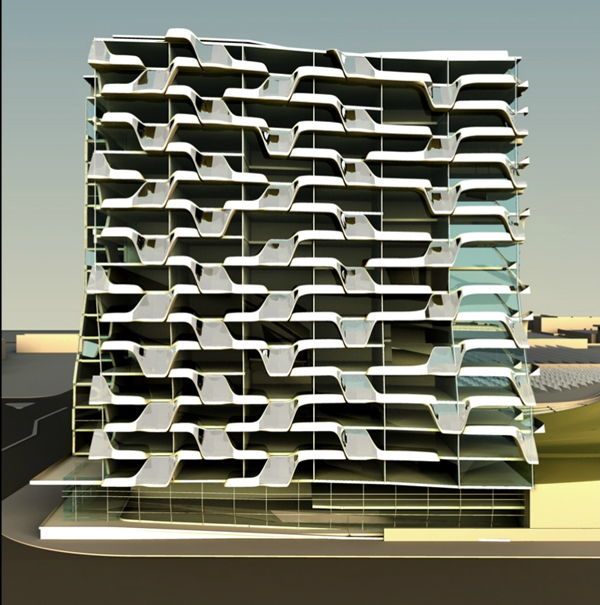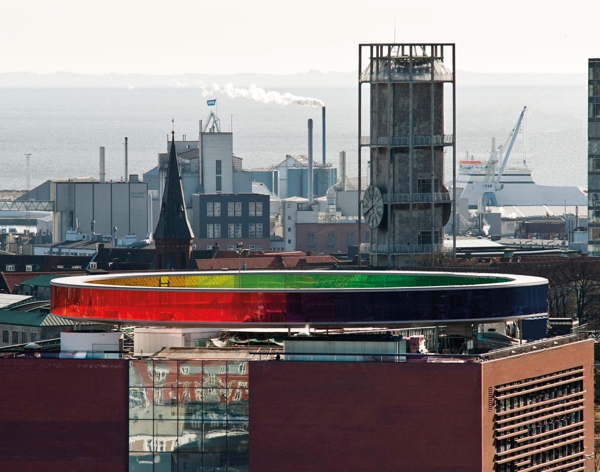The promise of 3d printing for usable mass consumed objects seem to have been just around the corner for nearly a decade now. A new formulation cement-based polymer developed by Rael San Fratello Architects in partnership with the University of Washington and University of California Berkeley replaces more expensive powder mediums for large scale objects. The prototype SeatSlug bench is a demonstration project of the potential of the material and 3d printing process to make sophisticated large pieces using low cost, non repetitive objects. The bench is comprised of 230 individual pieces, each developed as a unique shape. The cement based polymer has a compression strength of 4700 pounds but cost up to 90% less than conventional fusible powders. Rapid 3d printing technologies have been traditionally used to create relatively expensive prototypes for industrial design or more recently small scale objects with low cost devices. Read the rest of this entry »
SeatSlug – First 3d Printed Bench at a Low Cost / Rael San Fratello Architects
Target Tower / Belzburg Architects
Target, the box retailer who’s appeal for quality design at low prices has not been evident in their store design commissioned the Target Tower. The concept store, unveiled by Belzburg Architects, is an attempt to reorganize the urban retail experience. A residential tower looming above is the expression of how density drives a better marketplace. The store itself spreads out in an undulating fashion with elevations rising, falling and merging to create a more naturalized effect. The multiple scales of the project are intended to provide mass and density to the city while still providing an approachable exterior that does not overwhelm the neighborhood.
This concept is a rebranding of sort, creating high design principles with integrated sustainable practices takes recent developments in Wal-Mart retail stores and adds a distinctive architectural narrative. Daylight within the store is added with large perimeter windows and slivers of skylights though the main body of the building. The perimeter is also scaled to meet street level, creating a more approachable store front. Read the rest of this entry »
The Infinite Space: Stockholm Public Library / Bundi Pradono Architects
A proposal by Budi Pradono Architects for the Stockholm Public Library is based on a suspended slab set upon two large transparent pilotis. The simple conceptual form provides multiple benefits, anticipating a complex program to accomplish the difficult task for a contemporary library as both public venue and research retreat.
The library’s two collection floors are elevated to provide a more welcoming street front with a large plaza forming at the base of the building. The transparent columns contain various public spaces to engage group activities such as studios, an auditorium, restaurant, news room and reading areas as well as a office. The open view shed protected by the large mass above provides an open and compelling space to socialize in, acting as a communications hub for the city. Read the rest of this entry »
Milson Island Sports Stadium / Allen Jack + Cottier
Set on a small island on Hawkesbury River in New South Wales, Australia the Milson Island Sports Stadium goes to great lengths to engage with the environment. The building is used for sports activities and performance and is a organic backdrop for camp assembly set in the natural confines of the island. Allen Jack + Cottier Architects designed an oval shaped span with a plywood skin for a 30% lighter structure to simplify erection on the site which is accessed only by boat.
The stadium was set to the side of an open area as not to become overbearing on the site. The oval shape is glazed the bottom four feet in vision glass for children to have a direct connection to the outside. Interior light bleeds out night to illuminate the adjacent land but cuts glare and avoids light pollution. Natural light is filtered into the interior by a series of roof skylights set above grills. Read the rest of this entry »
CASEXP Ecological Space Unit / João Diniz
A proposed environmentally friendly housing development for marginalized communities located in the foothills of Betim MC, Brazil by Architect João Diniz solves multiple design issues with a basic structure. Modular in nature the housing stacks on each other to provide improved lateral egress to the outdoors while adapting to the variations of hilly terrain. The CASEXP ecological space unit is a 12×3 meter modular which can be secured to four posts and has a front and back wall section which folds down. The units are designed to stack, providing vertical densities which also allows for the green roof to act as living space. The post foundations minimize ground disturbance and protects against storm water. Placed in a series of clusters to promote community interaction east-west orientation is emphasized to reduce solar heat gain. Read the rest of this entry »
Resonance: Geometry and Sound Animation with 30 Artists
The short series of films in the project Resonance are works by teams of audio artist and studios paired with visual artist and studios. Based on the idea of matching geometry (SEE) with sound (HEAR) each movie vignette is an abstract experiment of 4D design immersion. Organized by SR Partners, over 30 groups participated.
Pieces are 20 seconds long or less and represent a diverse set of design modeling formulations both in content and aesthetic, with only occasionally representational or natural backgrounds incorporated. Narrative is downplayed in the short pieces, with both organic and geometric kinetic forms often shape shifting, changing scale or context matched with corresponding soundscapes. Sounds are musical and descriptive of the movement, using ambiance techniques to underscore the tone of the visual environment. Read the rest of this entry »
Your Rainbow Panorama / Olafur Eliasson
ARoS Aarhus Kunstmuseum in Denmark’s second largest city’s is newly crowned with a glass rainbow ring that transforms the cities vista into ever changing hues. Olafur Eliasson’s “Your rainbow panorama” is the final level of the museums symbolic ascension through Dante’s 9 circles of hell in the Divine Comedy. The circle, set above the rooftop, is the crescendo of that journey into light. Measuring 52 meter in diameter and 150 meters long the skywalk is entered from a roof deck. The full spectrum of colors is achieved by sandwiching up to 6 colored sheets in-between two plates of glass. The effect of the circular walk and slowly transitioning changing in color acts as a visual meter of the city view. Read the rest of this entry »
The Octopus Tower / MAKE Architects
Nicknamed ‘The Octopus’ for its distinctive shape, MAKE Architect’s 49.5 meter tower singularly rises above the m4 motorway in Chiswick, London. The controversial proposal, first rejected for it elaborate signage which was considered a distraction to traffic, has been newly unveiled but still maintains the distinctive shape and LED skin which will project advertisements and information for motorists. The LEDs are set in “cups” to reduce glare light pollution and energy density but allow the building to change character. The design is intended to draw attention to itself, not only revitalizing the site but reinvigorating local development and becoming a architectural landmark for London’s West End. Read the rest of this entry »
The Pod Exhibition Pavilion / Studio Nicoletti Associat
The dramatic effect of The Pod Exhibition Pavilion betrays the simple forms that it is composed of. A series of ovals stacked horizontally and offset which create a dynamic undulation through the greenscape is a centerpiece for a large urban development in Petaling Jaya, west of Kuala Lumpur.
Studio Nicoletti Associat used the water drop as inspiration for the mixed use office and showroom. The building is divided by a pinched middle and offset sections. The “Pod” is tubular steel wrapped in a white aluminum skin which dramatically changes color under differing lighting conditions. A reflecting pool surrounding the front of the building returns the light and provides connection to the design germ. The pavilion is to be a central iconic design inspiration for the surrounding project, providing aesthetic context for the entire large development.
The interior is amply day lit with bands of glass between elliptical sections while the offset portion containing offices have more conventional site glazing. Space is visually stretched by the stepped ceiling which provides graduated light through the volume. The surrounding greenscape, pool, and high albedo skin should effectively cool the building. Read the rest of this entry »
Process Zero: Retrofit Resolution Wins Next Generation Design Competition
Metropolitan Magazine’s The Next Generation 2011 Design Competition winner is a team of emerging architects and engineers who propose bringing an existing GSA building office building in downtown Los Angeles to net-zero energy. The design team, consisting of members from Vanderweil and HOK, used the design principles of the Living Building Challenge 2.0 to radically modify the building’s infrastructure and program.
Process Zero: Retrofit Resolution uses bio-engineering processes to create energy onsite, process all waste water and clean polluted air. The southern façade is retrofitted with tubes to farm algae which will be feed carbon rich air from the freeway. The algae will then be feed into a bio-reactor to create lipids than can be stored and burned in a combined cycle generator. Much of the building’s waste water will be used in the process and finally filtered in ponds adjacent to the office.
A full arsenal of technologies are proposed to reduce the building’s energy needs including ground source heat pump powered chillers connected to chilled beams, Energy Recovery Ventilation, waste heat coils, natural ventilation and radiant floors along with energy producing and harvesting solar technologies. The technologies are highly organized to use natural energy and systems before relying on conventional means. Read the rest of this entry »
























